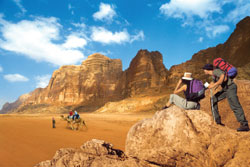
SIP tea in the desert in a black bedouin tent. Walk in the footsteps of Roman centurions. Discover the Rose Red City of Petra and float in the Dead Sea... and after all these activities, you are only just scratching the surface of the Kingdom of Jordan.
Commercially, politically, historically, Jordan has always been at the centre of the Middle East and today should always be on the top of ‘must-see’ list for visitors to the region.
The Hashemite Kingdom of Jordan is oozing history and you can spend your entire vacation wandering around some of the most remarkably well-preserved Roman ruins in the world, but it is always a good idea to start in the capital city of Amman.
Originally built on seven hills, just like Rome, today the city lies sprawled over 19 hills. Over 3,000-year-old Amman has been actively involved in trade through the millenia with Cyprus, Greece, Syria and Mesopotamia. Today, the modern city has plenty of good hotels, nightclubs and discos as well as a choice of shopping in modern malls or a traditional souk.
Once you have your bearings you will realise that the Jordanians are among the friendliest people in the Middle East. At our first visit to Jordan, we hired a car in Amman and were trying to find the exit to the Old King’s Highway going south. The windows of our car were open and at a roundabout, second time around, I was arguing with my husband and son about the correct route. A Jordanian driving a huge truck heard us and shouted for us to follow him. We did and were soon going along the right route. We stopped to thank the young man, who had gone out of his way to be helpful and was by now miles away from his own destination. As it turned out he had been to college in Denmark and was delighted to be able to converse once again in Danish.
Before leaving Amman visit The Citadel, which towers above the city. It was originally the site of the city’s earliest fortifications. Numerous excavations show Roman, Byzantine and early Islamic remains. Important structures include The Temple of Hercules, The Omayyad Palace complex with an impressive gate¬ way and a lovely Byzantine Church. The Roman Theatre from 151 AD, built to seat 6,000 spectators, has been partially restored and is today often used for cultural shows.
Don’t miss visiting Jerash, which is situated only about 50 km from Amman. If you are one of travellers wishing to visit some of the major sightseeing spots on the globe, Jerash ought to be high on the list. The most amazing fact of Jerash is that less than 20 per cent of the original city has been excavated so far.
Today, visitors can explore the oval-shaped Forum and the Temple of Zeus. You can walk along the magnificent colonnaded avenue, where indentations from chariot wheels are visible and can be followed just like the Roman centurions did eons ago. Admire the Temple of Artemis and take along plenty of film for your camera.
Admittedly it is a long drive from Amman to the southern city of Petra. Apart from visiting many sights along the King’s Road, the first sight of the Rose Red City of Petra is well worth the long trek. Built by the Nabateans, who dominated the trade routes in Ancient Arabia, Petra was already a fortress city more than 2,000 years ago.
Today Petra is designated as a Unesco World Heritage site.
You reach the city through the Siq, a 2-kilometre long gorge with 100-metre high cliffs. The first sight is the Treasury, with its grand facade hewn from pink sandstone. Other spectacular buildings include The Temple of the Winged Lion, The Royal Tombs, The Monuments of Petra Valley. If you have the stamina, also visit the first-century monastery high above the Petra Valley.
Another popular tourist attraction is the Dead Sea, a landlocked salt lake situated 410 metres below sea level, the lowest point on the earth’s surface. The warm waters are rich in beneficial elements and you can just lie back and float.
In the desert East of Amman are several castles that are built by the Umayyad Dynasty in the 7th century AD. Qasr Al Haliabat or Hamman As Sarakh are both well worth visiting. It is often a good idea to hire a driver-cum-guide for visits in the desert, unless you are used to desert driving and can speak Arabic.
And last but not the least, there’s Wadi Rum, which was the scene of the filming of a great part of the movie Lawrence of Arabia and is dominated by rock formations called jebels. It is also the fort headquarters of the Desert Patrol Corps and home to around 4,000 village and bedouin nomads. The mounted Desert Patrol Corps members are a colourful sight with their bandoliers of bullets wrapped around their desert clothing.
The best time to visit Jordan is spring or autumn. Most nationalities can obtain a tourist visa on arrival at Amman’s Queen Alia International Airport.
